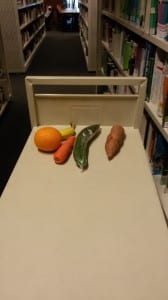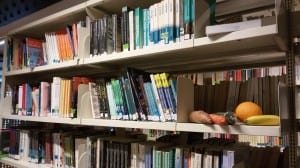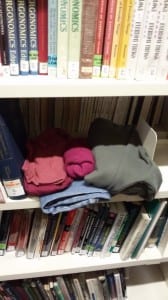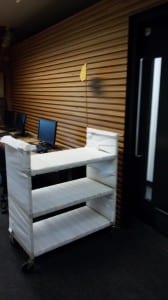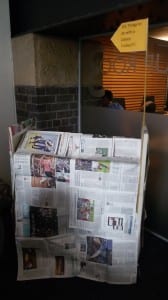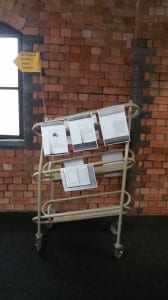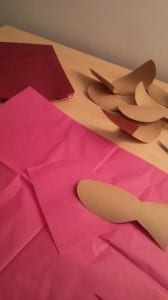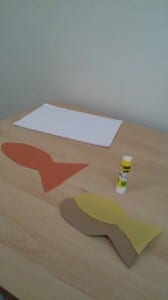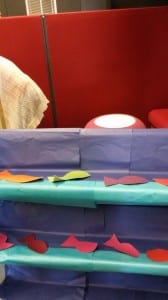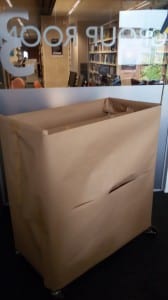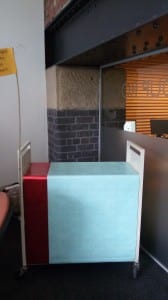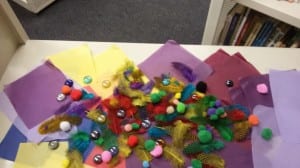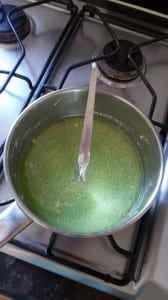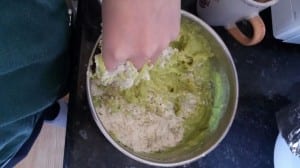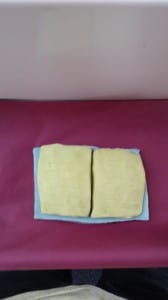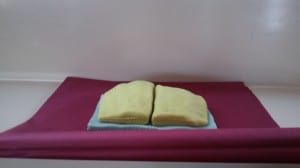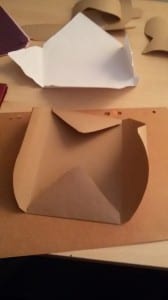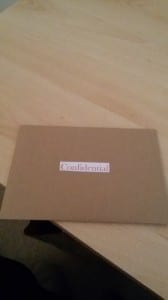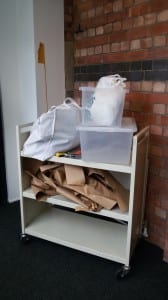Framing Statement
The final performance of our site specific performance “101 things to do with a library trolley” took place on the 8th of May 2015 in the Great Central Warehouse Library in Lincoln. It lasted from 9.30 a.m. until approximately 4 p.m.
The trolleys are essential to the working processes of the library, serving as tools to facilitate the purposes of the library. We wanted to take them away from their utilitarian existence and explore 101 alternative ways to use them. In Fluids (1967) Allan Kaprow built structures from ice and left them in twenty sites around Los Angeles until they melted. “Kaprow believed in the organic connection between art and its environment and that “the `quasi-architectural structures` of the ice blocks would activate the place for the spectator, encouraging them to see the site from a new perspective as the structures transformed the environment before transforming themselves into puddles of water.” (Govan, 2007) In the same spirit, our aim was to transform the trolleys and through transforming the trolleys also transform the environment of the library.
Another work which inspired us was Cie. Willi Dorner`s project bodies in urban space. A group of dancers placed themselves in certain spots around a city as if part of the architectural or utilitarian structures of the city, thus underlining or contradicting them (Cie. Willi Dorner, 2007). This performance called attention to inanimate things such as signs, stairs, doorways and benches, but because of the bodies that were now shaped around them, people were able to perceive the objects and the space in a new way.
“What becomes important […] is also the social practices that are engendered as part of the space-making processes of the particular site that an artist may observe, articulate and manipulate.” (Govan, 2007) When doing a site specific project one must consider those social practices which created the site and which are still part of the site. The library is a work space and is generally used for research or educational purposes. “101 things to do with a library trolley” was a complete clash with those purposes. Some of our 101 tasks were meant to integrate themselves into the regular workings of the library. Others were meant to contrast with them, thus “[challenging] notions of easy congruence between performance and site: […] the `fit` [was] not […] a comfortable merging with the resonances of the site but […] a reaction against them.`” (Pearson, 2010) We were aiming to create moments of amazement caused by the apparent absurdity of the tasks. In this sense, our piece was a “connection between art and everyday life” (Pearson, 2010). With some of our tasks we were aspiring to make mundane objects and activities seem bizarre, much like Gob Squad in their piece called Work in 1995. This took place in an office building and the performers appeared to be working in this office. They “interacted with telephones, photocopiers, filing cabinets, yet, […] they sought to `make strange` the activity” (Govan, 2007).
Analysis of Process
The work for our project started with the collection of ideas and the creation of a list of 101 things to do with a library trolley. We then divided that list between the four of us so that everyone was responsible for 25/26 things. After this, since there were many things to think about, we made a schedule for the day of the performance. We wanted to perform the 101 tasks on end with no gaps in between. Some of them were going to be performed by just one person, some by two or three and some by all four of us. Therefore, coordination and planning was key. Everyone had to know exactly what they were going to do at what time. Our initial estimate was for each task to take three to five minutes, but we later adjusted this time, assigning 10 minutes to each task to incorporate difficulties. For the final performance we booked group room 3 on the first floor to store the equipment and prepared the trolleys for their tasks.
After the planning we each had our 25/26 tasks to think about. I will talk about what my tasks where and how I approached them in a moment. First of all, I had to make a list of the equipment I would need and start to collect it. I also went to the props cupboard at the LPAC. I decided which tasks would need practicing and which would only be done in the performance to lend spontaneity to it. Another thing to consider was on which floor each task should take place. The effect a task had was different depending on which floor it took place because the atmospheres on the separate floors differ greatly from each other.
The first task was arranging the trolleys outside of the library. We had to try this to find out in which places they would transform the environment in the best way. The interest in washing (a mundane task) the trolleys (mundane objects) lay in calling attention to the activity. We took them outside and, rather than just wiping them down, washed them with water and sponges. The original plan in filling the lift with trolleys was to only have trolleys in the lift and let them go up and down by themselves. This might have caused moments of surprise when the doors opened for people. However, as we had to get permission from the library for each task, I asked and unfortunately was told that someone would have to be inside the lift with the trolleys. Each one of the “replacing the books with objects/clothes/food” tasks happened on a different floor. I took books out of a shelf and moved them to group room 3, using the trolley in its traditional way. When I came back out the trolley would hold either objects, clothes or food and therefore be turned into a shelf, wardrobe or shopping cart. Likewise, the shelf in which I then placed the items was transformed as well. This also presented an interesting visual effect (see the pictures below).
Some of my tasks involved wrapping the trolleys. This was inspired by Christo and Jeanne-Claude who create a lot of work which involves wrapping natural structures or man-made structures such as buildings, and monuments, with fabric, cloth or textile. For example, in 1968/69 they wrapped one million square feet of the Little Bay coast in Sydney using fabric and ropes. In 1985 they wrapped the Pont Neuf in Paris (Christo and Jeanne-Claude, 2015). My idea was to cover the original structure of the trolley to turn it into something else. I chose toilet paper and newspaper as materials which connect to the library. Toilet paper is used at the library, completely unrelated to the actual purpose of the library, whereas newspapers – journals, magazines – are things which can be found on the shelves of the library. Through wrapping the trolley and attaching pages of novels I intended to change the relationship between the trolley and the literature. Usually a trolley is loaded with books, turning the trolley into a means of transport and the books into something that needs to be transported. Instead of this relationship in which the books are weighing down on the trolley, I wanted to highlight the beauty of both trolley, and novels in decorating the trolley with novel pages. I changed this task later as we were also going to use one of the ergonomic trolleys in the final performance. The somewhat lighter structure of that trolley sympathized well with the idea of reversing the notion of a heavy load of books resting on the trolley. Therefore, I did not wrap it but instead hung the pages from it, creating the impression of a mobile. The idea of the aquarium was oriented on the concept of the children`s game of using a box to make an aquarium. The trolley was this box and I wrapped it in blue paper and put colorful paper fishes in it. The wrapping for those tasks happened where people could watch. The wrapping for the parcel and gift, on the other hand, was done inside group room 3, because they involved moments of surprise. The parcel trolley was going to be pushed to the ground floor with the intend of causing wonderment as to what was inside. The gift wrapping paper was going to be wrapped around the trolley with one of my group mates in it. The trolley was going to be pushed to a study floor and left there. She then was going to appear unexpectedly. All of these tasks needed much preparation. First of all, I had to get a lot of equipment and I then had to try each task to see how it would look and how much of each material I would need. I also had to pick the novel pages and make the fishes for the aquarium. Please see the pictures of all of these wrapping tasks below.
There was another kind of tasks which involved a person performing an activity on a trolley. I was reading a book and drawing a picture while being pushed on a trolley. We tried these tasks to see if pushing and navigating would be possible. These tasks are obviously activities connected to the arts and to the library. Just by the fact that they were performed on a trolley, they had a powerful effect when we tried them out. It was subtle but presented a very strange picture. It was, however, yoga on the trolley which caused the most interesting, astounded looks from people. For this I had to learn a few yoga positions and then try them on the trolley to see if I had enough space and could hold my balance. Yoga fitted very nicely into the quietness of the third floor while at the same time being a symbol of the importance of the balance between intellectual and physical activity. For making the trolley into a piece of art I created a sign saying “The Library Trolley”, such as an object in a gallery might have as a title. The trolley was meant to be transformed into a precious, valuable piece of art by treating it as such. Turning the trolley into a piece of art in this way was also going to turn its surroundings into a gallery. We were acting as a person working at a gallery and a visitor of the gallery. This worked very well on the silent study floor. For the task of collecting objects around the library I got things such as glass pebbles and feathers. I put them in the shelves across one of the floors. Then I went around with the trolley to collect the objects and arranged them on the trolley. This was an illustration of how, much like when gathering knowledge, things can be collected from different sources to, step by step, create something beautiful (see the picture below).
Making books out of play dough connected to the notion of reproduction and documentation. Documentation can be done purely for archiving purposes, but on a deeper level it means to take one thing and translate it into another medium, such as picture or film. In site specific performance, this can mean the creation of a new piece of performance. The play dough book was a reproduction of the books in the library. At the same time, it was the transformation of a book into a new medium, thus the creation of something completely new. “The reproduction of a painting or object, however perfect, is always, definitively, its betrayal.” Reproductions are sensitive “to their own limits, they are willing to concede the impossibility of reproducing the object” (Kaye, 2000). Below are pictures of the play dough I made at home and of the final result.
For the secret mail, my group mates were seated on different tables across a floor and I came up to one after the other with the trolley. The trolley held an envelope saying “confidential”. They each opened it, read the letter inside and put it back. This task was meant to create the notion of a shared secret. The fact that the letter was being delivered on a trolley highlighted its significance. Please see pictures of the envelope below.
For the construction site, the trolley was going to have large boxes and bags on it (please see picture below). One person was going to appear with the trolley, unload it at a place in the library and then push the empty trolley away. It was going to create the assumption that something large was going to be built or was going to happen. Then a second person was going to appear with an empty trolley, coming from the other side, load everything on the trolley again and leave with it, completely diffusing the suspension. I borrowed large boxes from the props cupboard at the LPAC but I also used the bags I brought on the day of the performance which contained all my equipment. This was going to happen on the third floor as the notions of silence and construction site would be a vast contrast.
With the couch trolley I reversed the roles of a couch and a library trolley. It required pillows and a blanket and me sitting on the trolley. Meanwhile, books were placed not on the trolley but on a chair. The best friend and the bag trolley both involved taking the trolley with us everywhere we went but not pushing it like a trolley. For the first one we treated the trolley like a person. This meant, for example, talking to it and hugging it. For the latter one, the trolley was holding things which are usually held by a bag. This was experimenting with the concept that a bag is used for its convenience whereas taking a large trolley everywhere is not convenient. The comments-about-the-trolley-project-in-the-library-box trolley held a box and pens and paper, giving people the opportunity to leave positive or negative thoughts about our performance. At the same time, it gave us a means of evaluating our performance.
For our final rehearsal we performed eight of our tasks in a row. Please follow this link for video footage of this rehearsal: https://youtu.be/2LsJaYPQu0M. The rehearsal provided us with a good sense of how well we were organized and how physically demanding the work was. One of the tasks I did for this was to push the trolley. In the final performance it was going to involve all four of us each having a trolley and walking across one floor making sure to cover every bit of the room. The trolleys were going to be empty and pushed for the sole purpose of pushing them. The interest in this task, when I tried it, lay in how to deal with obstacles. It was important for this task to navigate around obstacles and to always keep moving.
Performance Evaluation
Our final performance worked well in terms of its organization. All of our tasks went smoothly like we had planned them. We also saw reactions of interest and surprise from people. However, after a few hours of performance we were told by library staff that they had received some complaints about noise. We therefore had to adjust our performance accordingly. We tried to take more care in opening and closing the doors quietly and we were pushing the trolleys more slowly to reduce the noise. Unfortunately, our group let itself be influenced to the extent that we performed many of the tasks inside of group room 3 and in the small bit of corridor in front of the group room. I am not sure that this was the appropriate way to handle the situation. The experience as emphasized how crucial it is to know exactly what you are aiming to achieve. When working in a non-traditional venue, especially if it is a work space such as a library, you need to be aware, as a team of performers, whether the work you are presenting is in harmony with the space or if it is “a reaction against [the resonances of the site]” (Pearson, 2010). If you are doing the latter, you need to accept that some individuals might not agree with your work. We did expect this but did not intend to change our performance to the degree that we eventually did. It would have been good to prepare for the final performance by doing our tasks for a longer period on end. This way we could have seen the reactions we would get and whether a particular weekday or time of day would work best. Nevertheless, this would not have been a very reliable indicator as not the same people are at the library at always the same time. “At site, the audience may be incidental […] and obdurate.” (Pearson, 2010) One aim of any site specific performance should be “to both locate and relocate the individual, drawing their attention to the site whilst simultaneously challenging pre-conceived notions of the site when the real world is shifted momentarily “out of focus” (Hunter, 2012). If you cannot achieve this result and wish to adjust your performance, it is very important to find the right way to do so. If I could do the performance again I would place the trolleys in different locations over the library and perform the tasks without moving the trolleys. Another good idea would be to take the trolleys outside. This would take the performance to a new level. Not only would it be 101 alternative ways to use the trolley but it would also take the trolley to an alternative environment.
Please find below a montage of our final performance or follow this link: https://www.youtube.com/watch?v=XbS_O70DEl0.
Bibliography
Christo and Jeanne-Claude (2015) [online] Available from http://christojeanneclaude.net/artworks/realized-projects [Accessed 10 May 2015].
Cie. Willi Dorner (2007) [online] Available from http://www.ciewdorner.at/index.php?page=work&wid=26 [Accessed 11 April 2015].
Govan, E. (2007) Making a Performance: Devising Histories and Contemporary Practices. London: Routledge.
Hunter, V. (2012) ‘Moving Sites’: Transformation and Re-location in Site-specific Dance Performance. Contemporary Theatre Review, 22 (2) 259-266.
Kaye, N. (2000) Site-Specific Art: Performance, Place, and Documentation. New York: Routledge.
Pearson, M. (2010) Site-Specific Performance. Basigstoke: Palgrave Macmillan.
